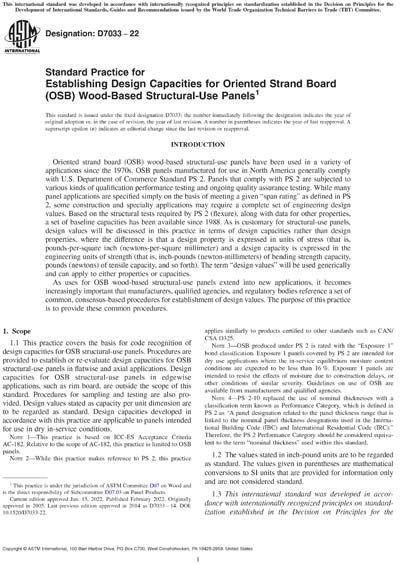Most recent
ASTM D7033-22
Standard Practice for Establishing Design Capacities for Oriented Strand Board (OSB) Wood-Based Structural-Use Panels
1.1This practice covers the basis for code recognition of design capacities for OSB structural-use panels. Procedures are provided to establish or re-evaluate design capacities for OSB structural-use panels in flatwise and axial applications. Design capacities for OSB structural-use panels in edgewise applications, such as rim board, are outside the scope of this standard. Procedures for sampling and testing are also provided. Design values stated as capacity per unit dimension are to be regarded as standard. Design capacities developed in accordance with this practice are applicable to panels intended for use in dry in-service conditions.
Note 1:This practice is based on ICC-ES Acceptance Criteria AC-182. Relative to the scope of AC-182, this practice is limited to OSB panels.
Note 2:While this practice makes reference to PS 2, this practice applies similarly to products certified to other standards such as CAN/CSA O325.
Note 3:OSB produced under PS 2 is rated with the "Exposure 1" bond classification. Exposure 1 panels covered by PS 2 are intended for dry use applications where the in-service equilibrium moisture content conditions are expected to be less than 16 %. Exposure 1 panels are intended to resist the effects of moisture due to construction delays, or other conditions of similar severity. Guidelines on use of OSB are available from manufacturers and qualified agencies.
Note 4:PS 2-10 replaced the use of nominal thicknesses with a classification term known as Performance Category, which is defined in PS 2 as "A panel designation related to the panel thickness range that is linked to the nominal panel thickness designations used in the International Building Code (IBC) and International Residential Code (IRC)." Therefore, the PS 2 Performance Category should be considered equivalent to the term "nominal thickness" used within this standard.
1.2The values stated in inch-pound units are to be regarded as standard. The values given in parentheses are mathematical conversions to SI units that are provided for information only and are not considered standard.
1.3This international standard was developed in accordance with internationally recognized principles on standardization established in the Decision on Principles for the Development of International Standards, Guides and Recommendations issued by the World Trade Organization Technical Barriers to Trade (TBT) Committee.
ASTM International [astm]

